This year's coast-to-coast wildfires in Canada have already emitted an estimated one-and-a-half billion tonnes of CO2. That's triple the annual climate pollution from burning fossil fuels in Canada. It's more than the combined emissions from 100 nations. And there are still months of fire season looming ahead.
As extreme as this year's wildfire emissions have been, they are just the latest escalation in a multi-decade flood of CO2 pouring out of Canada's "managed" forests and forestry. (Note: Canada only reports emissions from the parts of the forest it "manages." This is around two-thirds. Some managed forest areas are managed for logging, while others are managed for non-timber uses like recreation, water, wildlife and fire protection. See the endnotes for a map and more details.)
To illustrate the scale and pace of our metastasizing forest carbon crisis, I turned to data in Canada's official national greenhouse gas inventory, plus recent wildfire data from the European Union's Earth Observation Program. The resulting chart below shows the cumulative amount of CO2 that's been added to the atmosphere from Canada's managed forest since 1990.
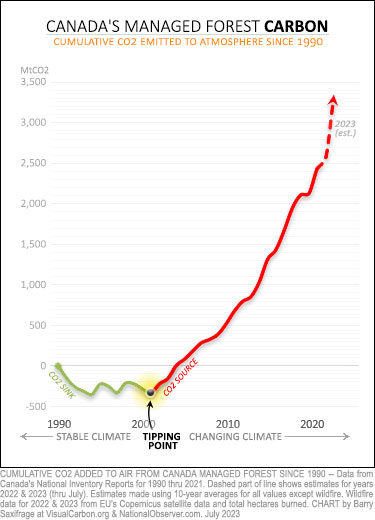
The falling green line at the start of the chart shows that in the early 1990s, the forest was a valuable carbon sink, helping to slow global warming. Back then, new forest growth absorbed more CO2 from the air than was emitted by logging, wildfire and decay.
That all changed after 2001, the tipping point year for Canada's managed forest.
As the rising red line on the chart shows, since that year, the forest has emitted more CO2 than it has absorbed. A lot more. Logging, wildfires, insects and the many forms of decay are now turning trees into CO2 faster than the forest can grow back.
That pumped billions of tonnes of climate fuel into the atmosphere — even before accounting for this year’s epic wildfires (shown by the dashed line). With those included, the cumulative total since the tipping point year is now around 3,700 million tonnes of CO2 (MtCO2).
22 straight years of emissions
To appreciate just how dramatic the tipping point has been, take a look at this next chart. It uses the same data, but this time breaks it down into individual years.
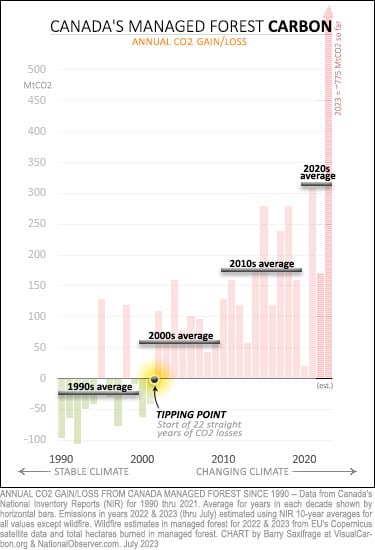
Years when Canada's managed forest removed CO2 from the air are shown in green. For example, that first green bar in 1990 shows the forest absorbed 100 MtCO2 more than it lost that year.
Red bars show the opposite.
Notice how every year since the tipping point has been a red year. That's 22 straight years in which Canada's managed forest lost carbon to the atmosphere. This clearly isn't a problem caused by a few freak years. It’s an every-year crisis.
And this crisis is escalating. You can see how the decade averages are rising relentlessly (black horizontal bars).
Let's look at what happened in the last decade. During the 2010s, forest carbon losses added an average of 175 MtCO2 per year to the atmosphere. That's more than most nations emit, and yet Canada isn't even counting it in our national total. The atmosphere, however, most certainly is. The more CO2 it gains, the more extreme the climate crisis becomes.
Any guesses on how many Canadian gasoline-burning cars we must take off the road to offset that much CO2? All of them. Plus all our heavy-duty freight trucks and every other form of fossil-fuelled road transport. Oh, and we also must stop burning natural gas in every Canadian home.
Even that might not be enough. Because, as the chart shows, average emissions from our managed forest are running even higher so far in the current decade. The first time Canada's forest carbon emissions exceeded 300 MtCO2 in a single year was in 2021. And this year's emissions are already double that record.
There is this feel-good myth in Canada that our massive forest is offsetting some of our massive fossil fuel emissions. That might have been true decades ago under our old, stable climate. But we’ve so weakened our forest — through decades of business-as-usual industrial logging and fossil-fuelled climate shifts — that it has switched to hemorrhaging CO2 instead of absorbing it.
Now we find ourselves in the opposite situation. Now, we must reduce our oversized fossil fuel emissions even faster, just to offset surging emissions from our managed forest and forestry.
If you're like me, you're probably starting to worry about how out-of-control this could get.
Tip of the iceberg
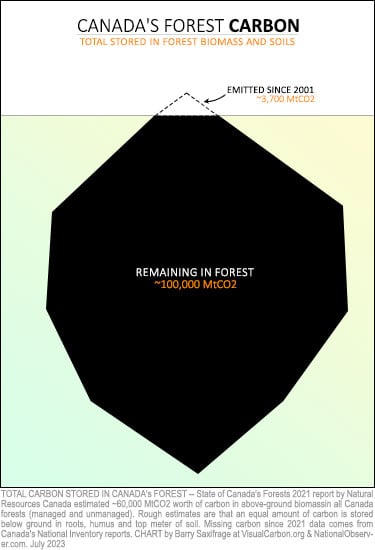
Canada's forest is one of the largest terrestrial carbon storehouses on the planet. It contains billions of trees spread across hundreds of millions of hectares.
Just how much forest carbon are we talking about? One recent study by Natural Resources Canada estimates the above-ground biomass alone contains enough carbon to produce 60,000 MtCO2. A similar amount is currently held in roots and soil. In total, our nation's forest easily holds 100,000 MtCO2 worth of carbon.
So, the roughly 3,700 MtCO2 lost to the atmosphere since 2001 is just the tip of our nation's gigantic forest-carbon iceberg. There is more than enough carbon remaining to fill Canadian summers with raging megafires and toxic smoke for centuries to come. More than enough to overwhelm the climate pollution cuts we make elsewhere as we fight to get to net-zero greenhouse gas emissions.
Having a gigantic amount of forest carbon was a hugely valuable gift under our old, stable climate. It provided jobs, energy and materials that magically replenished themselves each year from thin air. As a bonus, all that forest carbon also helped cool the planet.
But decades of business-as-usual logging and fossil-fuel burning have transformed this valuable gift into a growing threat. Canada’s managed forest is looking less and less like a carbon bank — and more and more like a carbon bomb.
Defusing this gigantic carbon bomb will require addressing the two main drivers of forest carbon losses — industrial logging and fossil fuel burning.
Logging more than grows back
For the last two decades, industrial logging has been extracting far more carbon from Canada’s managed forest than has grown back. That’s added billions of tonnes of CO2 to the atmosphere.
My next chart shows the details.
Canada reports managed forest CO2 in two parts — from in the forest and from the wood hauled out of it.
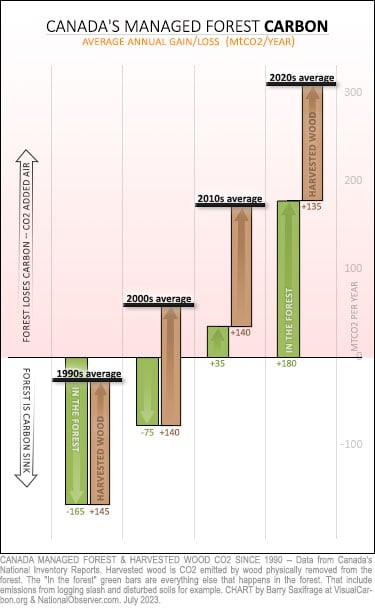
The first part is shown by the green bars. This is the net balance of CO2 removed from the air by new growth minus CO2 emitted by fire and decay. You can see how dramatically this balance has flipped from absorbing CO2 to emitting it.
The second part is the CO2 emitted by wood hauled out of the forest. This is known as "harvested wood products" and is shown by the brown bars. Notice how harvested wood levels have remained very high — at around 135 MtCO2 per year — even as forest growth has totally collapsed.
You can see how back in the 1990s, logging extracted about the same amount (brown) as the forest grew back (green). Maybe that could be considered carbon-neutral, depending on the conditions.
But during the 2000s, logging extracted twice as much carbon as grew back. And since then, we've been logging a forest that isn't growing back at all. That isn't carbon-neutral. It's climate crazy.
For those of us hoping to prevent a full-blown climate breakdown, the obvious question is: How much of the CO2 pouring out of our forest is caused by logging? Or put another way: Can we reduce the climate threat by logging less?
How much CO2 is caused by logging?
It's been 35 years since Canada first promised to cut emissions (spoiler alert: we haven't). By now, you'd think our government would at least report how much CO2 a huge industry like logging adds to the atmosphere. But it doesn't.
The government has the data — but they mix critical logging emissions data in with other forest emissions. For example, I asked Environment Canada for something as basic as the emissions from all dead biomass that logging leaves behind in the forest each year (often referred to as "slash"). The department said they track it but declined to provide the number.
Environmental groups have been trying for several years, with little success, to persuade the government to accurately and transparently report logging emissions. Recently, the Natural Resources Defense Council (NRDC) and Nature Canada published their own estimates using the limited government data available.
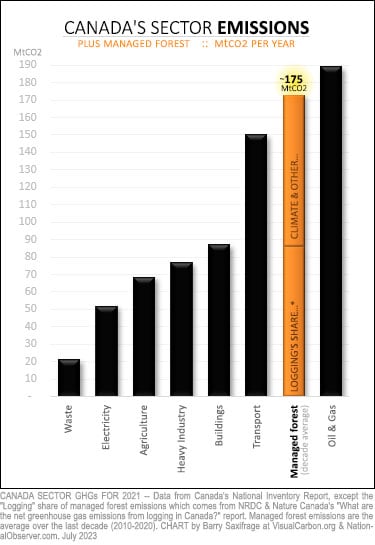
In their report, "What are the net greenhouse gas emissions from logging in Canada?", they calculate an average over the last decade of 86 MtCO2 per year. As my next chart shows, this rivals the emissions from heavy industry and buildings. Unlike other sectors, however, Canada exempts this logging industry CO2 from emission pricing or climate targets.
As this chart also shows, the total emissions from our managed forest averaged 175 MtCO2 per year during the last decade. That rivals our two worst sectors — transportation and the oil and gas industry. The additional forest CO2 beyond what is caused by logging has primarily been caused by fossil-fuelled climate changes.
So let's look at that next.
Fossil-fuelled death and decay
Fossil fuel burning is rapidly overheating and destabilizing our climate.
Canada's forest is especially vulnerable because temperatures are rising here two to three times faster than the global rate. That's driving rapid changes in wildfires, lightning, drought, snow cover, stream flows, water temperatures, insect outbreaks, disease, melting permafrost and a Pandora's box of other environmental shifts.
Trees don't get to move when fossil fuel pollution turns their climate hostile. Instead, they weaken, grow less and fall prey to turbocharged outbreaks of insects, fungi and disease. More trees die. And many more burn as fossil-fuelled heat and droughts unleash extreme megafires.
Natural Resources Canada is blunt about the threat in its State of Canada's Forests 2020 report: "Scientists predict that increasing temperatures and changes in weather patterns associated with climate change will drastically affect Canada’s forests in the near future. With the rate of projected climate change expected to be 10 to 100 times faster than the ability of forests to adapt naturally."
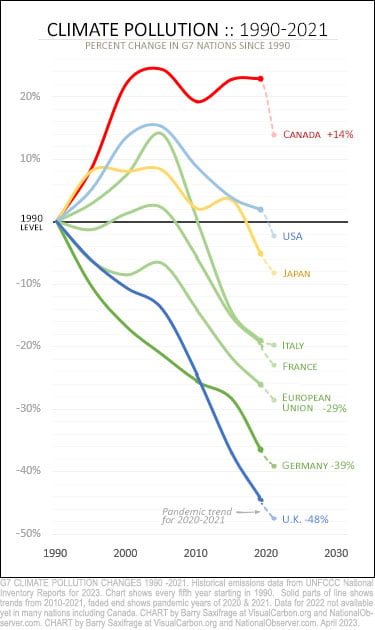
These climate impacts will grow ever more extreme until we stop burning fossil fuels.
Despite decades of promises, that's something we haven't even started to do in Canada.
You can see how Canada’s doing compared to our peers in the Group of Seven (G7) in this next chart. Collectively, these wealthy, industrialized nations emit one-third of global climate pollution and produce half the world's GDP. If we are going to have any shot at preventing a full-blown climate crisis, this group with much of the world's financial resources, capabilities and talent must lead the way.
As you can see, all of our G7 peers emit less than they did in 1990. And, importantly, all of them were reducing emissions in the years before the pandemic crash (dotted lines on chart).
Not Canada. We are the only one still polluting far more than when we started promising to cut emissions more than three decades ago. And we were the only G7 nation still increasing our emissions before the pandemic hit.
We know it is possible for advanced economies to slash emissions. Just look at our Commonwealth peers, the British. They have the world's sixth-largest economy — one and half times the size of Canada's. They've cut their climate-destabilizing emissions in half. We know what works, we just aren't acting.
Canada's forest is in trouble. And so are we
The dangerous reality is that we've knocked our forest off balance with unrelenting fossil fuel burning and chainsaws. It's now struggling and losing wood at an increasing pace. Forest growth has collapsed past the tipping point, while our logging continues at old-climate levels.
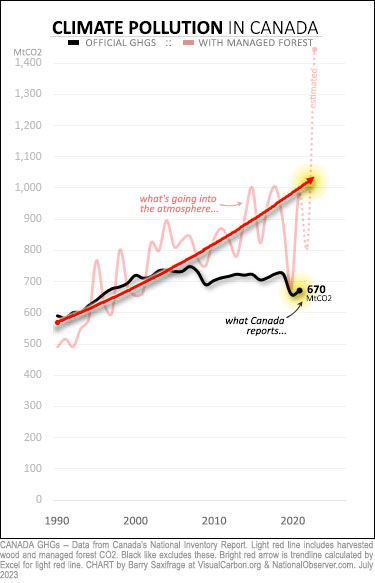
Unlike some ecosystems we've destabilized, however, our forest isn't going quietly. It bleeds climate-destabilizing CO2 by the megatonne. And much of it chokes our cities in apocalyptic shrouds of toxic smoke.
We might be ignoring this rising flood of CO2, but the climate isn’t. It doesn't care about our pencil-pushing tricks and excuses. It just reacts blindly to the amount of CO2 piling up in it.
My final chart shows the rapidly growing difference between the climate pollution that Canada officially reports (black line) and the amount actually going into the atmosphere (light red line).
That doesn't look to me like we are cutting off the flow of climate fuel and heading toward climate safety. It looks like we are in deep trouble.
Canada's managed forest is a gigantic carbon bomb. Decades of surging emissions from it are a flashing red light, warning that we are at risk of it running away from our control.
Is that the dystopian legacy we want to leave for countless generations of Canadians that follow us? If not, we need to start taking the threat seriously and act to defuse it while we still can.
-----------------------------
ENDNOTES
-----------------------------
Estimates of Canada's 2023 wildfires emissions
- In an interview with Bloomberg Green, Werner Kurz, a senior research scientist with Natural Resources Canada, estimated 1,420 MtCO2 had been emitted so far this year (through July 18).
- Using satellites, Copernicus Atmosphere Monitoring Service (CAMS), the European Union's Earth observation program, estimated 1,060 MtCO2 had been emitted this year (through July 31).
For comparison, all fossil fuel burning in Canada emits around 550 MtCO2 per year. That's around 80 per cent of Canada's official greenhouse gas total. The combined emissions of the 100 least-emitting nations total 1,250 MtCO2, according to climatewatchdata.org.
The difference between managed and unmanaged forest in Canada
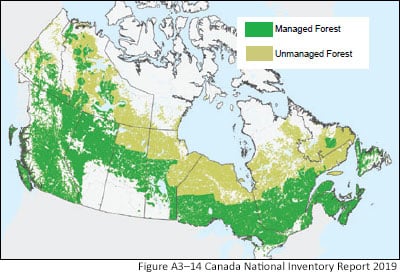
Canada only reports emissions from the parts of the forest it "manages." This is around two-thirds of its forest (shown in darker green on this map).
Some managed forest areas are managed for logging, while others are managed for non-timber uses like recreation, water, wildlife and fire protection.
Unfortunately, Canada reports emissions from all managed areas mixed together. The failure to report logging areas separately and transparently obscures the emissions caused by logging and encourages policies that increase the climate threat.
What are the emissions from Canada's "unmanaged" forest?
As noted, Canada doesn't report emissions from the one-third of its forest that it considers "unmanaged." Are these areas absorbing CO2 … or emitting it as well?
As I wrote last year, the best information I've been able to find has been a study by Natural Resources Canada, which estimated Canada's total forest (managed plus unmanaged) has lost four billion cubic metres of wood volume from 1990 to 2019. It's enough wood to stack a billion cords of firewood — or build four homes for every Canadian.
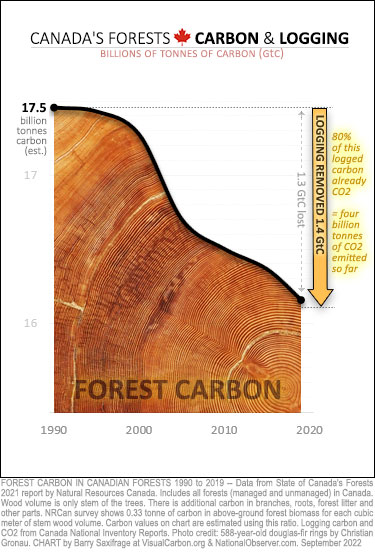
It also matches the amount of wood logged out of Canada's forest over those same years. So even on the grand scale of all Canadian forests, they haven't been able to replace any of the wood volume logged out of them since 1990.
From a climate standpoint, the missing wood contained around 1.3 billion tonnes of carbon. That turns to 4,800 MtCO2 when it eventually burns or rots. As shown in the first chart in this article, the managed part of the forest emitted 2,500 MtCO2 over those years. This seems to indicate our unmanaged forest has also been emitting CO2.
You're probably thinking that we wouldn't have to guess if I'd just asked Natural Resources Canada to tell me how much wood was lost in the managed and unmanaged forest areas. Well, I did just that. Natural Resources Canada said it can't tell me because, amazingly, it doesn't even use those categories.
Why and how I estimated 2022 and 2023 managed forest emissions for this article
Canada takes up to two years to report emissions. So, it will be a loooooong time before we get government numbers for last year and this year. Climate change, however, isn't waiting around while our government drags its feet. It's moving dangerously fast. And we now need to as well.
So, to try to give a sense of the huge carbon shocks unfolding in recent years, I had to estimate Canada's managed forest emissions for the last two years.
If you want the nitty-gritty, here's what I did:
- I used the 10-year averages for harvested wood and all other forest emissions — except wildfire.
- I estimated the wildfire component using hectares burned. That gets reported quickly. Specifically, I calculated average wildfire CO2 per hectare burned in the last decade and applied that to hectares burned in 2022 and so far in 2023. That resulted in wildfire CO2 estimates of 122 MtCO2 for 2022 and 750 MtCO2 so far for 2023 (through July 25). That's just for the managed forest. The rest of this year's estimated wildfire CO2 I've assumed is occurring in unmanaged forest.
Calculating logging industry emissions
One way to calculate logging emissions is to sum up all the logging sources of CO2 and then subtract the CO2 absorbed by logged forest areas. Here's a general idea of what data would be needed versus what's available.
Logging CO2 sources include:
- CO2 from trees cut and hauled out of the forest. Canada reports this as "harvested wood."
- CO2 from the trees and biomass cut and left behind in the forest. This is sometimes called "slash." Canada tracks this but reports it mixed in with non-logging sources. So, we don't know how much slash CO2 logging causes.
- CO2 from disturbing carbon-rich soils. Logging exposes soil in a way that increases carbon decay into CO2. Canada also tracks this but again, reports it mixed it in with non-logging sources. So, we also don't know the amount caused by logging.
- CO2 from burning fossil fuels. Canada reports forestry emissions from this mixed in with agriculture and fishing.
- CO2 from logging roads and landings. A recent study showed that a significant part of logged land doesn't grow back for decades because it is scarred by logging roads and landings. Canada doesn't yet account for this in its forest models, which can overstate CO2 removal in logged areas.
- CO2 from making forest landscapes more vulnerable to fire and decay. Logging replaces natural primary forests of mixed ages and species with single-age, monocultural tree farms. These tree farms are often more vulnerable to fires, insects, droughts and storms — turbocharging CO2 emissions from them. Seedlings and young trees are also more vulnerable than the mature trees they replace. Canada tracks the CO2 from tree farm areas and from unlogged primary forests but doesn't report them separately.
Logging CO2 sinks:
- CO2 is absorbed by new growth in logged areas. After logging, the trees that regrow absorb CO2. When new growth exceeds the emissions from fire and decay in these areas, then that logged area is a net CO2 sink. We need to know the total CO2 sink (if any) from logged lands in Canada to calculate how much of the harvested wood CO2 has been pulled back out of the atmosphere. That determines whether the logged wood is carbon-neutral or a source of CO2. But, again, when Canada reports this, it mixes some logged areas in with areas that are managed for non-timber reasons, like parks. That hides the role logging is playing in the flood of CO2 pouring out of Canada's managed forest.
As this quick list makes clear, Canada isn't being transparent in how it reports forestry emissions. The inability to see the CO2 impact of logging is preventing citizens, policymakers, businesses and consumers from making sustainable and climate-safe decisions.
We can't defuse the carbon bomb that is going off in our forest without having clear data about which specific actions make it worse — and by how much.
Thousands of Canadians lost
Thousands of Canadians lost their homes, their property, millions of hectares of forest turned to ashes,
I have yet to read anywhere about the millions of animals and biodiversity lost to these wilfires, why is that?
During Australia's devastating bushfire season of 2019/2020 the world heard day after day of the countless animals torched alive, why not a line about these losses in our media?
The relationship between
The relationship between forest wildfires/ deforestation and our warming climate is a prime example of what climate scientists call a "positive feedback loop." And it's not a good thing. The more the climate warms, the more forest fires we have, which results in more CO2 being emitted in the atmosphere, which leads to more warming, which leads to more forests burning down. Scientists have warned us about positive feedback loops for years. And yes, they can lead to dangerous tipping points in the climate system. Maybe we're already there...
It's shocking to read Barry's stats about emissions from forest fires so far this year. Thank you for this info. But good luck getting forest companies to reduce their annual cut, or to get governments to demand it. And once again, we will need lumber to rebuild all those houses that have been burnt down...
I have to admit I feel pretty depressed about the whole situation. We have choking smoke in Kamloops today (from the surrounding wildfires) which doesn't help. I can even smell the smoke in my house. Time to get an air purifier I guess.
It's heartbreaking to see how many people have lost their homes to wildfire this year.
All this and the
All this and the Conservatives can only tweet that we dont have a problem. REALLY that is idiotic and unbelievable. I cant believe this mentality exists and people will actually vote for it. No wonder we are in trouble
If you believe that humans
If you believe that humans are contributing to climate change, YOU MUST VOTE. We need to change the present political direction if we want a chance for a reasonable future. Don't vote party, vote for our collective right to live on this planet and demand your representative will represent your view, not their political party's view.
Vote for whom, exactly?
Vote for whom, exactly?
Lots of luck with making demands of representatives. My Liberal MP calls herself an environmental activist; however, I've seen nothing from her office about reducing gas and oil extraction. The best on offer re Trans-Mountain was "I didn't vote for it."
Herbicide (glyphosate)
Herbicide (glyphosate) spraying is another significant factor adding to the flammability of our forests. The federal Pest Management Regulatory Agency should ban all forestry uses of glyphosate. Herbicide spraying kills the moisture-trapping hardwood understory and desiccates the forest.





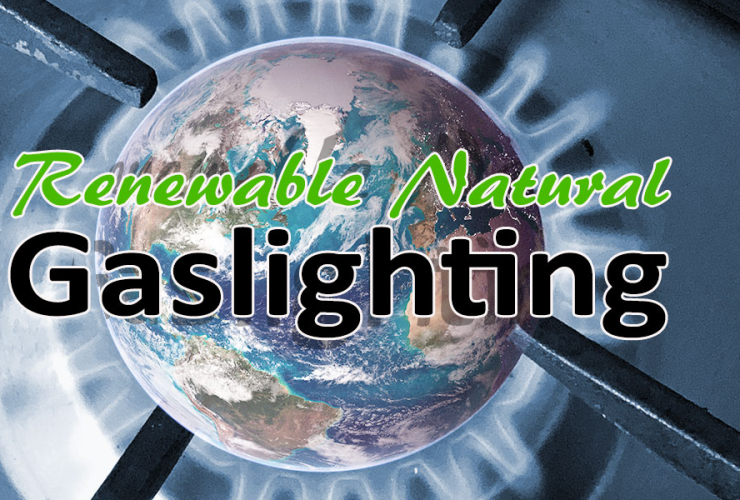

Comments